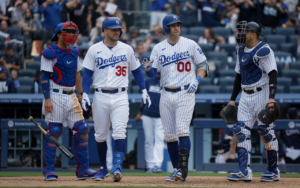Baseball is more than just a game; it’s a thrilling battle of statistics, skill, and strategy. Two teams that have captured the hearts of fans are the Baltimore Orioles and the San Francisco Giants. Each franchise has its unique history and a roster packed with talent. As we dive into this matchup, we’ll explore how these teams stack up against each other in terms of player stats.
From explosive hitters to ace pitchers, both teams bring their A-game every time they step onto the field. Will it be the power-hitting prowess of the Orioles or the crafty pitching from the Giants that reigns supreme? Let’s break down what makes these two clubs tick as we analyze their key players and match them head-to-head in various statistical categories. Get ready for an exciting journey through numbers that could dictate who comes out on top in this epic showdown!
Key Players on the Orioles and Giants teams
The Baltimore Orioles boast standout talents that spark excitement. Cedric Mullins shines as a dynamic outfielder, known for his speed and ability to get on base. He’s a cornerstone of the lineup and ignites rallies with his energy.
On the pitching side, John Means is a key figure. His finesse on the mound makes him a tough competitor. With an impressive repertoire, he can dominate even formidable lineups.
For the San Francisco Giants, look no further than Brandon Crawford. The veteran infielder combines defensive prowess with clutch hitting. His experience often leads pivotal moments in games.
Logan Webb represents the Giants’ pitching strength as well. Young yet poised, Webb has become one of their most reliable arms in crucial matchups, consistently delivering strong performances under pressure.
Comparison of batting statistics
When it comes to the Baltimore Orioles and San Francisco Giants, batting statistics reveal a lot about team strengths. Home runs often excite fans, with each team showcasing sluggers capable of turning games around in an instant.
The Orioles have made headlines with their powerful lineup, frequently leading the league in home runs. The sheer muscle behind their swings has kept opposing pitchers on high alert.
On the flip side, the Giants bring consistency to the plate. Their focus isn’t just on power but also on strategic hitting that accumulates runs over time. This balance can wear down even the best pitching staffs.
Batting average is another vital metric. While both teams aim for high averages, individual players shine differently under pressure. RBIs tell a similar story—each team’s ability to convert opportunities into scores highlights their offensive prowess when it matters most.
A. Home runs
Home runs are a game-changer in baseball. They can electrify the crowd and shift momentum in an instant. The Baltimore Orioles have had some powerful hitters who can send the ball deep into the stands. Their lineup boasts players with impressive power stats that keep pitchers on edge.
On the other side, the San Francisco Giants also feature sluggers capable of clearing fences. Their approach often combines strategic hitting with raw power, making them formidable opponents.
When comparing home run statistics between these teams, it’s clear both bring significant firepower to their games. Each blast not only adds to individual records but energizes entire lineups for potential rallies and victories. As fans watch closely, every swing holds promise for greatness or disappointment, showcasing how pivotal each player’s performance truly is in this aspect of the game.
B. Batting average
Batting average is often a key indicator of a player’s consistency at the plate. For both the Baltimore Orioles and San Francisco Giants, this stat reveals much about their offensive capabilities.
The Orioles have seen some impressive averages from their top hitters. Players who can maintain high batting averages contribute significantly to scoring opportunities. When they get on base consistently, it puts pressure on opposing pitchers and defenses.
On the flip side, the Giants also boast players with commendable averages. Their lineup includes athletes known for their ability to make contact and drive in runs when it counts. A solid batting average translates to more chances for extra-base hits or driving runners home.
Comparing these two teams highlights how critical each player’s performance is during games. This stat not only affects individual accolades but also impacts game outcomes dramatically.
C. RBIs
When analyzing RBIs, or Runs Batted In, both the Baltimore Orioles and San Francisco Giants showcase players who excel in clutch situations.
The Orioles have a lineup that thrives on driving runners home. Their approach focuses on consistent contact hitting, leading to impressive RBI totals. Key bats in their order are often found capitalizing with men on base.
In contrast, the Giants leverage power hitters who can clear the bases with one swing. This strategy results in sporadic but high-impact RBI counts throughout the season.
Both teams exhibit contrasting styles regarding run production. The Orioles rely more on manufacturing runs through small-ball tactics while the Giants look for opportunities to hit home runs that also bring runners across the plate.
As each game unfolds, these differences affect how they score and compete against opponents.
Comparison of pitching statistics
When comparing the pitching statistics of the Baltimore Orioles and San Francisco Giants, several key metrics stand out.
The ERA often serves as a benchmark for evaluating pitchers’ effectiveness. The Orioles have shown improvement in this area, with their aces stepping up to lower their earned run averages.
Strikeouts are another crucial factor. Both teams boast power pitchers who can dominate opposing lineups. The Giants have had some impressive strikeout performances this season, showcasing their ability to miss bats consistently.
Wins and losses tell part of the story too. While wins don’t solely reflect a pitcher’s skill, they provide context about how well offenses support them. The contrast between each team’s win-loss record highlights differences in overall team performance during games.
These stats not only reveal individual talent but also hint at teamwork dynamics on the mound.
A. ERA
Earned Run Average (ERA) is a critical statistic that showcases a pitcher’s effectiveness. It calculates the average number of earned runs a pitcher allows over nine innings. A lower ERA indicates better performance, making it essential for evaluating pitchers.
For the Baltimore Orioles, their starting rotation has shown promise recently. With emerging talents, fans are buzzing about their potential to keep scores low.
On the other hand, the San Francisco Giants have relied on veterans who bring experience to the mound. Their ability to manage pressure situations often results in keeping opponents at bay.
As we analyze both teams’ ERAs this season, every run saved can be pivotal in tight games. Each matchup could very well hinge on which team’s pitchers rise to the occasion when it matters most.
B. Strikeouts
Strikeouts are a critical measure of a pitcher’s dominance on the mound. They reflect not only the ability to overpower batters but also showcase strategic pitching skills.
The Baltimore Orioles have seen impressive strikeout numbers from their key pitchers this season. Their ace has consistently fanned hitters with precision and speed, leading the league in strikeouts per nine innings. This creates an intimidating atmosphere for opposing teams.
On the other hand, the San Francisco Giants rely on a combination of solid command and deceptive pitches. Their top pitchers excel at mixing speeds, often leaving batters guessing and swinging through strikes.
When comparing these two teams, it’s fascinating to see how each approaches strikeouts differently. The Orioles tend to emphasize velocity while the Giants focus more on finesse. Both strategies can lead to success but result in different game dynamics when they face off against each other.
C. Wins/Losses
The wins and losses of a team tell a compelling story. For the Baltimore Orioles, each victory represents resilience and growth. They have shown flashes of brilliance this season, turning close games into memorable moments.
On the flip side, the San Francisco Giants have had their share of ups and downs. Their win-loss record reflects both strong pitching performances and occasional offensive struggles. It’s a balancing act that defines their journey through the season.
Tracking these stats not only reveals where teams stand but also highlights trends that can influence future matchups. The pressure mounts with every game played; every decision counts in shaping their fate as they strive for postseason contention.
As fans watch closely, it becomes clear: wins and losses are more than just numbers on paper; they symbolize hope, effort, and determination from players who leave everything on the field each night.
Fielding and Defensive Statistics
Fielding and defensive statistics often tell a different story than offensive numbers. For the Baltimore Orioles, reliable fielding has been crucial in tight games. The team boasts strong infielders who consistently make routine plays while also exhibiting quick reflexes for challenging grounders.
On the flip side, the San Francisco Giants emphasize versatility on defense. Their outfielders have shown remarkable range, turning potential doubles into outs with their speed and arm strength. This agility helps them cover more ground to support starting pitchers effectively.
Errors can swing momentum rapidly during a game. Both teams have had their share of missteps this season but maintain solid overall fielding percentages that reflect their commitment to avoiding mistakes.
Advanced metrics like Defensive Runs Saved (DRS) further illustrate how each team’s defensive prowess impacts outcomes. As both squads strive for excellence, these subtle nuances in defense could hinge upon close matchups ahead.
Recent Performance and Team Dynamics
The recent performance of both the Baltimore Orioles and San Francisco Giants showcases their evolving dynamics. The Orioles have displayed impressive resilience, consistently finding ways to win close games. This grit has fostered a strong team spirit that energizes players each time they step onto the field.
On the flip side, the Giants are navigating through some ups and downs but remain competitive. Their ability to adapt mid-game reflects a deep understanding of strategy among players and coaching staff alike.
Injuries have tested both teams’ depth charts, leading to unexpected heroics from less prominent players. These moments highlight character and determination, weaving into the fabric of team identity.
As fans watch these two franchises clash, it’s clear that momentum shifts can change at any moment—keeping everyone on edge until the final out is recorded.
Conclusion: Which team has the statistical advantage?
When comparing the Baltimore Orioles and the San Francisco Giants, a clear picture starts to emerge. Both teams have standout players making significant contributions. The Orioles boast powerful hitters who can change the game in one swing, while the Giants rely on their strategic play and consistent pitching.
Looking at batting statistics reveals some interesting insights. The Orioles often excel in home runs, showcasing their ability to hit for power. On the other hand, the Giants tend to have higher batting averages that reflect their focus on getting runners on base consistently. RBIs tell another story where both teams can shine but may differ based on lineup strengths.
Pitching stats further illustrate each team’s capabilities. The ERA figures show how well each squad’s pitchers handle pressure during games—an essential element in close matchups. Strikeout rates highlight which team has more dominant arms taking control from the mound, while wins and losses provide a snapshot of overall performance throughout the season.
Fielding is another critical component of success that shouldn’t be overlooked. Defensive efficiency impacts run prevention significantly; errors can shift momentum quickly during crucial moments in any game.
Recent performance patterns indicate shifts within both rosters as they adapt through injuries or trades over time—a vital factor as we assess potential advantages going forward.
As these two storied franchises continue competing this season, player stats paint an intriguing narrative about their strengths and weaknesses against one another across various aspects of gameplay.












